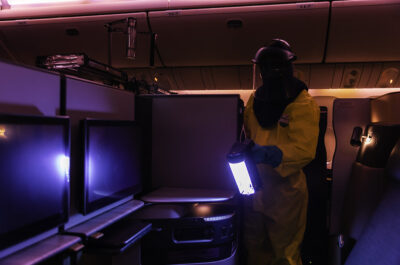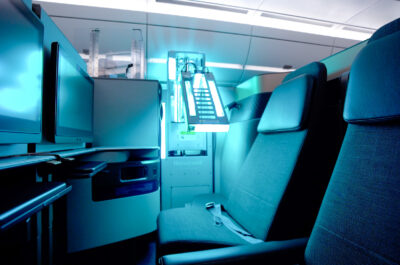Nearly 10,000 deliveries of new business jets valued at $250 billion expected through 2022. 30% of buyers are planning to replace or purchase new aircraft in the next five years. "BRIC" country purchase plans lead all world regions.
ORLANDO – In its 21st annual Business Aviation Outlook, Honeywell is forecasting nearly 10,000 new business jet deliveries worth about $250 billion from 2012 to 2022. The 2012 Honeywell survey reflects an approximate 9 percent increase in projected delivery value over the 2011 forecast. The expected gains come from pricing increases and a change in expected business jet mix, which reflects a continued trend toward larger business jet models.
Honeywell forecasts 2012 deliveries of approximately 680 to 720 new business jets, a single-digit increase over levels reported last year.
“Next year’s totals are anticipated to be of similar magnitude, reflecting the protracted nature of the global economic recovery,” said Rob Wilson, president, Honeywell Business and General Aviation. “Over the medium term, a return to historical growth conditions supported by globalization, wealth creation in developing nations and new aircraft development should boost orders and support accelerated growth beginning mid-decade. Despite the economic challenges our industry has been dealing with for the past 40 months, we believe some progress is being made.”
Survey findings
In its latest survey, Honeywell found that about 30% of operators interviewed have plans to purchase a new business jet over the next five years either as a replacement or in addition to the respondent’s fleet. This level of interest has been largely stable for the past three survey cycles, and compares favorably with results of 25% or less that were the norm until 2006, but below the peak of 40% in 2009. This year, about 20% of those with plans to purchase a new business jet intend to make it by 2013, with a similar proportion planning 2014 and 2015 purchases. The survey does not allocate specific years beyond 2015. This is similar to last year’s results and leads to a relatively stable level of projected demand in the near term.
Higher purchase expectations continue to be placed upon larger aircraft, implying they will command the bulk of the value billed from now until 2022. This class of business jet is expected to account for nearly 70% of all expenditures on new business jets. Volume growth between now and 2022 will also be represented by this class of aircraft, reflecting more than one-third of additional units and two-thirds of additional retail value.
“The trend toward larger cabin aircraft with ever-increasing range expectations and advanced avionics continues to be reflected in this year’s survey,” said Rob Wilson, president, Honeywell Business and General Aviation. “As a full spectrum supplier to the industry, Honeywell has been successful in building strong content levels on most of the more popular super midsize and larger aircraft in production or scheduled to enter service over the next few years.“
“The Honeywell operator survey has been an invaluable tool for the industry over the past two decades,” explained Carl Esposito, Honeywell Aerospace Vice President of Marketing and Product Management. “The annual outlook has helped guide our own product decision process that has led to focused investments such as designing and developing optimized propulsion offerings, flight efficiency upgrades, innovative safety products, and enhanced services.“
Regional buying details
Regional purchasing results are nuanced according to each market’s maturity, economic environment and other characteristics. Emerging markets generally show higher but historically more volatile levels of demand, as well as a more pronounced preference for larger aircraft. As developed markets’ performance strains under both economic sluggishness and business lifecycle transitions, emerging markets have been shaping the industry’s growth, backlog and portfolio composition or mix.
The overall level of forecast aircraft demand coming from outside North America continues to increase as projected. This year, roughly 53% of projected demand comes from North American operators, down two points from the 2011 survey.
Honeywell first spotlighted growth in the BRIC countries (Brazil, Russia, India and China) last year. In 2011, these results led the survey with 50% of respondents reporting acquisition plans. This has since lowered to 46 percent but with a firming profile. While last year less than one-third of BRIC purchases were planned to happen within two years, this year more than 40% of those surveyed say they intend to begin purchasing activity in the next two-year timeframe. Some signs of uncertainty regarding business conditions do show up in this group’s timing profile, with a marked increase of purchases not allocated to a specific year or placed by default in 2017.
Together, the emerging market results from BRIC countries reflect a slight tempering of enthusiasm compared to a year ago but are still quite strong when compared with other regions, or with results accrued during the more than 20 years Honeywell has been conducting this survey.
The Asia Pacific region, where many of the industry’s major players have high expectations for long-term future growth, reports 34% of its operators as interested in new purchases. This is lower than the 45% reported last year but remains above the world average and results in an aggregate share of world five-year projected demand of about 7%, off two points from 2011 levels.
Fleets in this region have been growing at double-digit rates throughout the past five years. This year more than a third of respondents planning to buy will do so within the first year, which improves chances of actual order placement and continued above-average near-term growth. When comparing purchase timing in Asia Pacific between the past two surveys, it is evident that this front-loaded profile was already in the making, with the timing of the bulk of acquisitions having simply shifted a year. The overall decline in purchase plans can therefore be partially attributed to a pause in backfill, probably influenced by a moderation of past exuberance and an economic tempering affecting the region’s major economies.
“It is critical to understand that demand from this part of the world remains well above the world average, and we do not believe the 2012 results represent in any way a change in the region’s fundamental underlying growth drivers or commitment to business aviation,” Wilson noted.
The share of projected five-year global demand attributed to the Middle East and Africa remained near the center of its historical 4 to 7% range again this year.
In the Middle East and Africa, 32% of respondents plan to buy a jet, down from 38% last year. Despite the fall off, the portion of respondents planning to expand their fleets in lieu of simply replacing an aging plane almost doubled. Operators in the region shared direct candid responses to our survey indicating their purchases may happen further into the next five-year timeframe, potentially influenced by recent political uncertainties.
Latin America’s survey results indicate 39% of operators have new jet purchasing plans, which is an improvement over last year’s 32%. Furthermore, planned acquisitions are more front-loaded than the world average, with almost 70% of this region’s projected purchases timed to happen within the first three years of the survey period. As with the Asia Pacific market, backfilling appears to have eased, albeit to a lesser extent. As a result of the improved purchase plan levels, Latin America’s share of total projected demand increased nearly five points from a year ago to 18%.
North America, the industry’s mainstay market, has had new jet purchase plan levels remain stable, totaling about one-fourth of all operators, for the past five years. However modest interest levels might be when compared with emerging markets, North America represents more than half of projected global demand for the next five years based on the region’s historically dominant installed business jet base, affirming the region’s place in the industry’s future.
Timing of North American acquisitions has been deferred compared with previous results, suggesting that despite overall similar interest levels demonstrated by potential purchasers, short-term conversion plans could be postponed.
Europe’s purchase expectations were up slightly this year, at 33% and are roughly in line with levels in the previous two surveys. The European share of estimated global five-year demand rose by one point to 18% in the 2012 survey. Much of the apparent resilience shown by local operators in the face of eroding economic conditions is actually just the result of geographical definition. Russia, with strong local purchasing ambitions, is included in this region, as are the central and Eastern European states, which are generally more economically robust.
Ancillary data from the Western European portion of the region conjure an environment of slowing activity and demand, strongly influenced by complex problems such as higher unemployment, high government debt and negligible growth.
A comparison of the planned timing for purchases between the past two surveys also shows a shift toward the latter portion of the five-year window.
“We continue to see underlying macro-trends that support potential demand for business jets, making the industry’s long-term prospects attractive,” Wilson said. “Other factors we believe will help accelerate global business aviation growth are long overdue structural and regulatory reforms, which have the potential to unlock significant spending power that would propel aviation expansion,” he said. “Product development, in the form of aircraft with higher productive potential, or even air traffic control systems with higher capacity and efficiency also create new markets and should continue to support expanded use of business aircraft as a key tool in the global economy.“
Flight activity
Shifting from jet purchases to flight activity, over the course of the past year, the pace of recovery has effectively paused on several fronts. This leaves much of the ground lost by operations during the 2009 recession still to be recaptured. A full recovery remains several years away at current and near-term projected rates of flight activity.
Among the indices followed by Honeywell, jets for sale and flight activity merit special attention.
The number of fielded jets for sale today is diminishing slowly. Approximately 12% of today’s fleet is in play, down from a high of more than 15% reached in 2009. Current levels are almost normal in light of the past decade’s history, and recent trends indicate the number should continue to shrink slowly.
Younger inventory (jets 10 years old or less) usually make up less than 20% of what is for sale, but this year their ranks have hovered around a quarter of all listings. This is down from record averages of about 30% reached in 2009. More crucially, improvements recently stopped, adding another cautionary note to overall market trends.
Prospects for improved levels of flying activity in the near future are modest. Honeywell expects American business jet cycles to close this year with a small contraction of about 1%, mostly attributed to sluggish corporate operations, offset in part by relatively strong charter operations. Next year should bring growth in the low single digits, presaging a slow, multiyear path back to historical normalcy.
European activity in 2012 — which does not include Russia in this case — is expected to decline approximately 3%. Another contraction of equal magnitude is expected in 2013, driven not only by weak economic prospects in Western Europe but by recent fleet declines. Renewed recovery in flight volumes is not anticipated until 2014. On a brighter note, recent Russian Business Aircraft Association figures indicate that flight activity levels in this fleet are expanding at mid-single-digit levels.
Operator reported planned changes in business jet utilization in regions outside Europe and North America mirror the lugubrious pace of improvement expected in the mature regions with neutral to very modest plans for increased levels of activity.
Fractional market
Flight activity for charter-like operations and fractional ownership appears to be doing relatively well in the U.S., but not translating into many new aircraft deliveries. Fractional operators have taken only five new jets this year, while shedding 11 other aircraft. NetJet’s large order of 425 aircraft from Bombardier and Cessna have boosted backlog figures, and should yield stronger delivery performance later if economic growth resumes a more quotidian pace in developed economies.
Additional operator insights
In this year’s survey two common themes emerged from operator responses around the world. Demand from developing markets, while significantly higher than mature markets, now is more reflective of cooling economic conditions. In addition, economic conditions, elections and government responses to budget growth, debt and aircraft-related legislation and regulations in all areas of the world will naturally play into near-term purchase plans. Operators in every region expressed concerns over the regulatory environment — particularly user fees and tax laws. Still, when looking ahead, most operators surveyed believe that local economic growth will be stable or improve in the near term.
Theodore is the Co-Founder and Managing Editor of TravelDailyNews Media Network; his responsibilities include business development and planning for TravelDailyNews long-term opportunities.





























































































































































































































